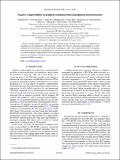Negative compressibility in graphene-terminated black phosphorus heterostructures
Author(s)
Wu, Yingying; Chen, Xiaolong; Wu, Zefei; Xu, Shuigang; Han, Tianyi; Lin, Jiangxiazi; Skinner, Brian J; Cai, Yuan; He, Yuheng; Cheng, Chun; Wang, Ning; ... Show more Show less
DownloadPhysRevB.93.035455.pdf (1.320Mb)
PUBLISHER_POLICY
Publisher Policy
Article is made available in accordance with the publisher's policy and may be subject to US copyright law. Please refer to the publisher's site for terms of use.
Terms of use
Metadata
Show full item recordAbstract
Negative compressibility is a many-body effect wherein strong correlations give rise to an enhanced gate capacitance in two-dimensional (2D) electronic systems. We observe capacitance enhancement in a newly emerged 2D layered material, atomically thin black phosphorus (BP). The encapsulation of BP by hexagonal boron nitride sheets with few-layer graphene as a terminal ensures ultraclean heterostructure interfaces, allowing us to observe negative compressibility at low hole carrier concentrations. We explain the negative compressibility based on the Coulomb correlation among in-plane charges and their image charges in a gate electrode in the framework of Debye screening.
Date issued
2016-01Department
Massachusetts Institute of Technology. Research Laboratory of ElectronicsJournal
Physical Review B
Publisher
American Physical Society
Citation
Wu, Yingying, Xiaolong Chen, Zefei Wu, Shuigang Xu, et al. "Negative compressibility in graphene-terminated black phosphorus heterostructures." Phys. Rev. B 93, 035455 (January 2016). © 2016 American Physical Society
Version: Final published version
ISSN
1098-0121
1550-235X